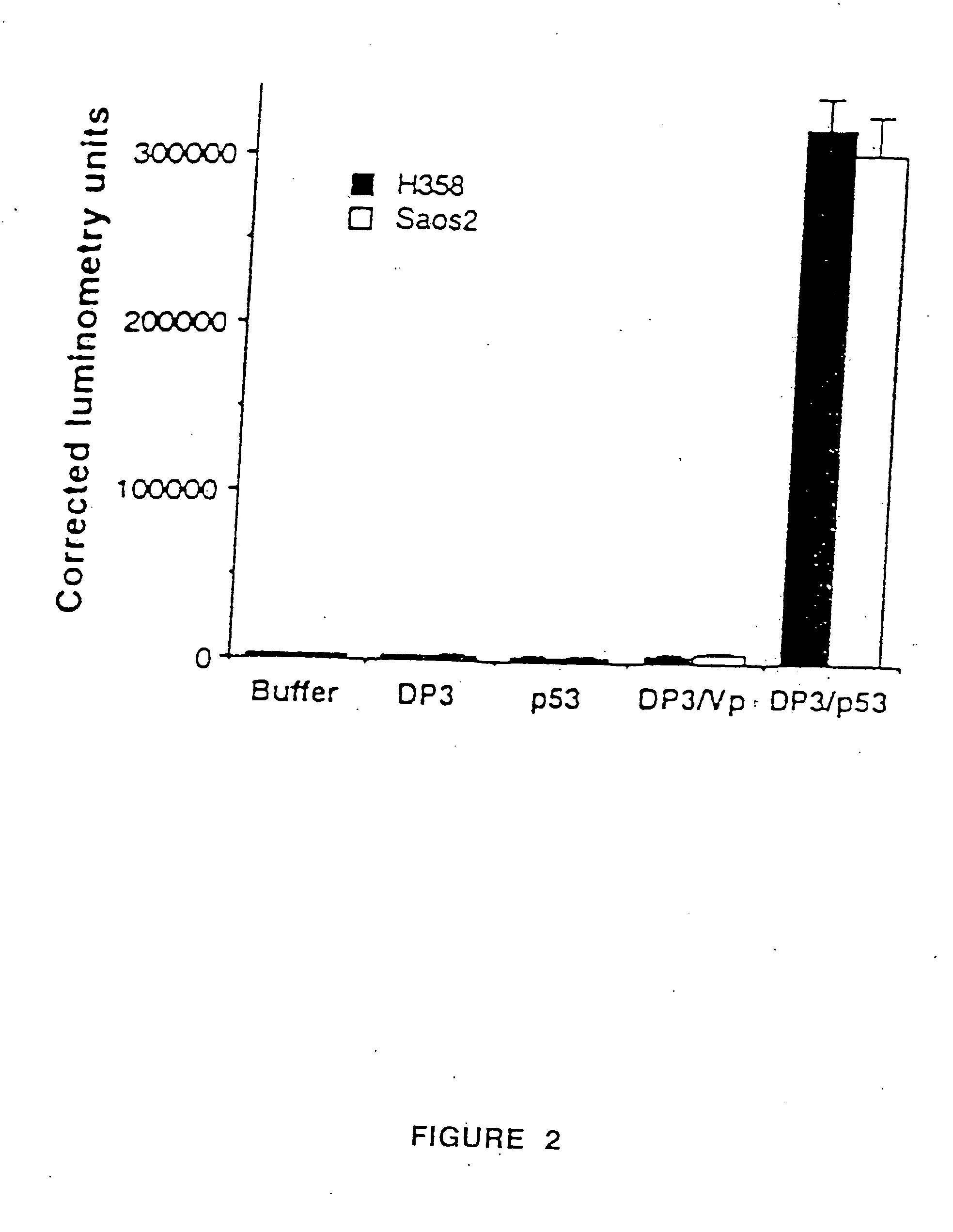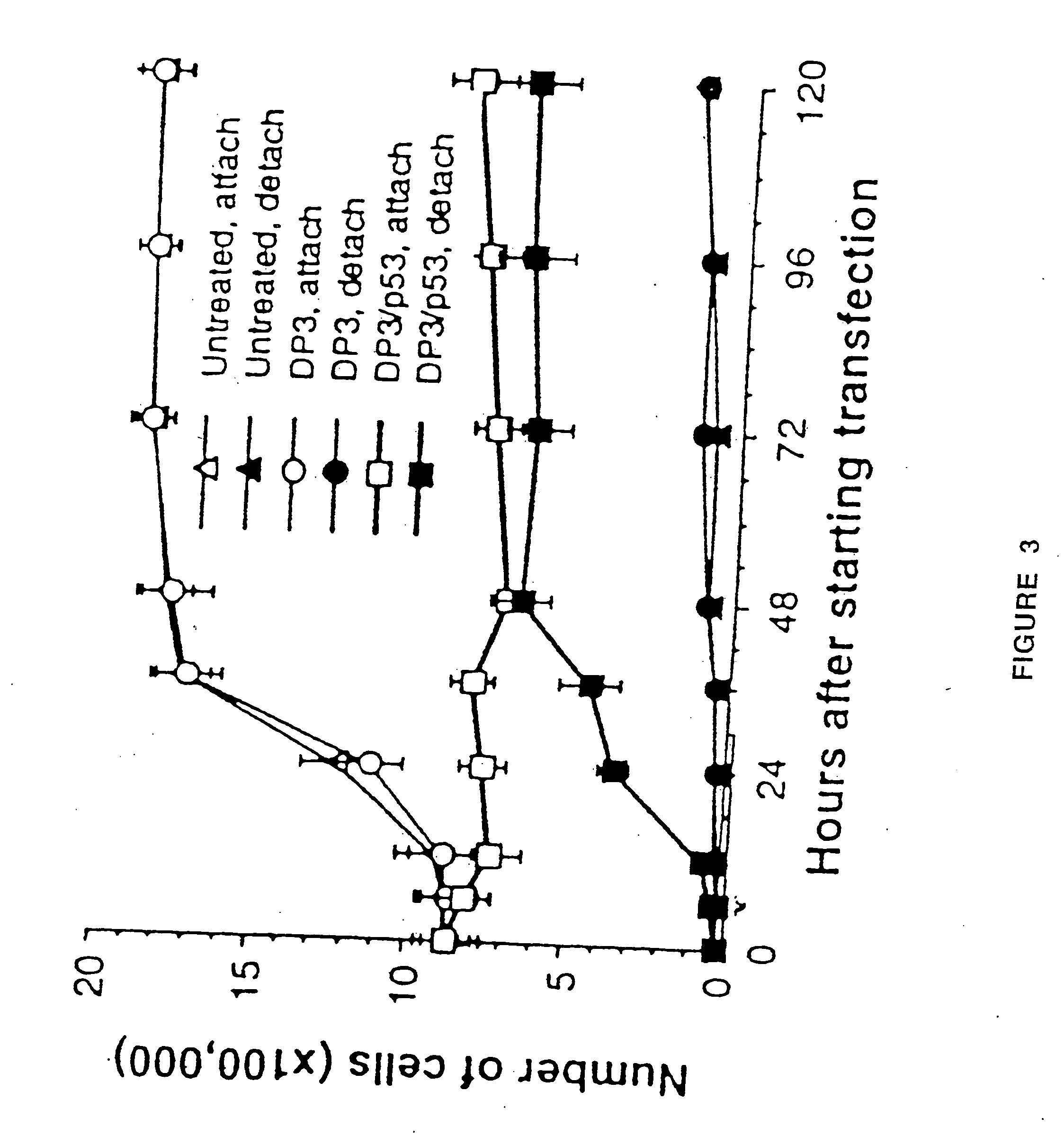Gene therapy of tumors using non-viral delivery system
a delivery system and gene therapy technology, applied in the field of gene therapy and cancer therapy, can solve the problems of poor prognosis, lack of effective preventive interventions and therapies for advanced cancers, toxic and immunogenic effects, etc., and achieve the effect of effectively killing human beings, reducing lung cancer mortality, and effectively treating bronchial premalignancy and early bronchial malignancy before i
- Summary
- Abstract
- Description
- Claims
- Application Information
AI Technical Summary
Benefits of technology
Problems solved by technology
Method used
Image
Examples
example 1
Liposome Formulations
[0029] The present invention discloses a cationic liposome gene delivery system intended for aerosol administration to treat bronchial premalignancy and malignancy. Various liposome / DNA formulations using different cationic lipids, liposome sizes, lipid / DNA ratios, and DNA doses were tested in six human cancer cell lines and normal bronchial epithelial cells to screen for high transfection efficiency and low toxicity. DP3 liposome was chosen to form liposome / DNA complex (DP3 / p53) with a human wild-type p53 expression plasmid (pC53SN) based upon its relatively high transfection efficiency and low toxicity compared with other cationic liposome formulations.
[0030] In the preparation of different liposome formulations composed of cationic lipids, a wide variety of different lipid composition were used to prepared different liposome-DNA preparations using the Lac Z gene. All preparation obtained with commercially available individual cationic lipids were prepared ...
example 2
In Vitro Transfection Efficiency (Lac Z Gene)
[0032] These initial studies were performed using NIH3T3 cells and the Lac Z gene. 3-5×105 NIH3T3 cells / well were plated in 6 well dishes. Liposome-pCMV-b-gal(Lac Z) complexes in a serum-free medium were added to the wells and the cells were incubated at 37° C. with 5% CO2 air for 24 hours. Subsequently, the liposome-DNA complexes were washed out and medium supplemented with 10% FBS added. The b-galactosidase activity was determined at 24 hours post-incubation by x-gal staining (54); 6 different fields were randomly selected with at least 200 cells in each field. % transfection was expressed as the percent of blue-stained cells.
[0033] TABLE II shows the transfection efficiency is highly dependent on the lipid composition. The highest % transfection was consistently observed with Lf, followed by DP3.
TABLE IIFormulation% TransfectionNumber of exp.TDP311.2 ± 6.6 4Lf17.4 ± 8.4 10G678.5 ± 2.14L10.2 ± 0.33L20.3 ± 0.23L30.6 ± 0.33L41.7 ± 0....
example 3
Effect of Lipid: DNA Ratio on Transfection Efficiency (Lac Z Gene)
[0034] The experimental conditions were the same as for the experiments shown above. The DNA amount was fixed at 2 mg / well. Different lipid:DNA weight rations (1:1, 2:1, 3:1, 6:1, 12:1, and 24:1) were used. % transfection with each lipid:DNA ratio was calculated using the method described above. The experiments performed twice. TABLE III shows that the transfection efficiency can be optimized by altering the lipid:DNA ratio. The optimal lipid:DNA ratio varies amount the different formulations.
TABLE III% Transfection, lipid:DNA ratioFormulation1:12:13:16:112:124:1Lf—026238DP3—2591410DM3—511151—L5——0.547—L6——0.337—Lv——221—G534531——G677942——
PUM
| Property | Measurement | Unit |
|---|---|---|
| Size | aaaaa | aaaaa |
| Size | aaaaa | aaaaa |
| Size | aaaaa | aaaaa |
Abstract
Description
Claims
Application Information
 Login to View More
Login to View More - R&D
- Intellectual Property
- Life Sciences
- Materials
- Tech Scout
- Unparalleled Data Quality
- Higher Quality Content
- 60% Fewer Hallucinations
Browse by: Latest US Patents, China's latest patents, Technical Efficacy Thesaurus, Application Domain, Technology Topic, Popular Technical Reports.
© 2025 PatSnap. All rights reserved.Legal|Privacy policy|Modern Slavery Act Transparency Statement|Sitemap|About US| Contact US: help@patsnap.com



